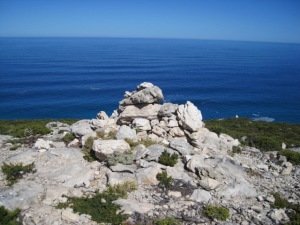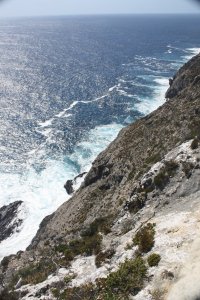The final chapter in this investigation of the Loch Sloy (there may be more to come!)
Previously, the researchers investigating the location of the burials of the people who drowned when the Loch Sloy sank off the Kangaroo Island coast in 1899, had searched archives, spoken to various people and made contact with members of the May family.
The time had come to make a decision about conducting a survey to see if there were any indications of burials. This took place in December 2011. The fitter members of the group (and believe me you have to be fit to walk through dense scrub and rocks for nearly three hours) undertook the walk out to our identified area, starting at Rocky River just near the tourist centre in Flinders Chase National Park. The other not so young, and not so fit researcher (me!) met with contacts at the Hope Cottage museum in Kingscote.
The intrepid explorers located the cairns that had been erected by the May family to indicate where the Loch Sloy went down, and some features near the cliff that looked like graves because of their orientation and the formal layout of rocks. The rangers at Flinders Chase were very helpful in suggesting different routes to the site that might prove less exacting.
One option was to start from Cape de Couedic and follow the ETSA track until it ended and then walk the rest of the distance. This may prove to be easier, we were told. Our contact with the Kangaroo Island Walking Group indicated that this walk had been done before.
Following this survey, we had to decide when would be an optimal time to conduct an excavation. Because of Amer Khan’s work commitments and the time involved in preparations and permits, we would not be able to return to Kangaroo Island until March 2012.
Permits were applied for and granted, funding was released and AARD (Aboriginal Affairs & Reconciliation Division, South Australian government) indicated that there were no known burials in the area we were going to investigate.
With everything in place, and with some students from Flinders University to help with the excavation, we returned to Kangaroo Island. Again, the fitter and younger people made the trek out to the site returning with massive blisters and the belief that the original route taken in December was the better one. Progress was made, though, and the features that had been previously identified as possibilities were excavated to bedrock, but disappointingly showed no burials.
However, these two trips provided extremely valuable information and insight into excavating in remote areas and enabled the researchers to meet people on Kangaroo Island who were extremely helpful and knowledgeable. Future investigations will focus on the exact location of the wreck and from that, and a re-look at the information, we may still find the graves.
It is hoped that, in the future, some sort of recognition of this shipwreck will be implemented. This may take the form of an event (with guests from the U.K.) at Kilpatrick’s grave and maybe interpretive signs telling the story. Another suggestion was that the beach where the survivors came ashore could be renamed the ‘Loch Sloy’ beach.
We all look forward to future involvement in this project and would like to thank everyone concerned from Kangaroo Island and mainland South Australia.
As a member of the research team (for my directed study) I have been able to observe how the processes for archaeological investigation work in a government department, and how an archaeologist works with people with different backgrounds and skills. It’s hard to know if we are any closer to finding the burials but the media coverage has unearthed new contacts that may be able to help. We are optimistic.
Even though my directed study with Flinders University Archaeology Department is now finished, I look forward to being involved in this project as a volunteer.
I would like to thank Jen McKinnon for putting my name forward for this project. I have learned so much Jen, thank you. I would also like to thank Heather Burke who, as ever, has been helpful in her comments and technical assistance throughout this topic.
Watch this space for more blogs in the future!



